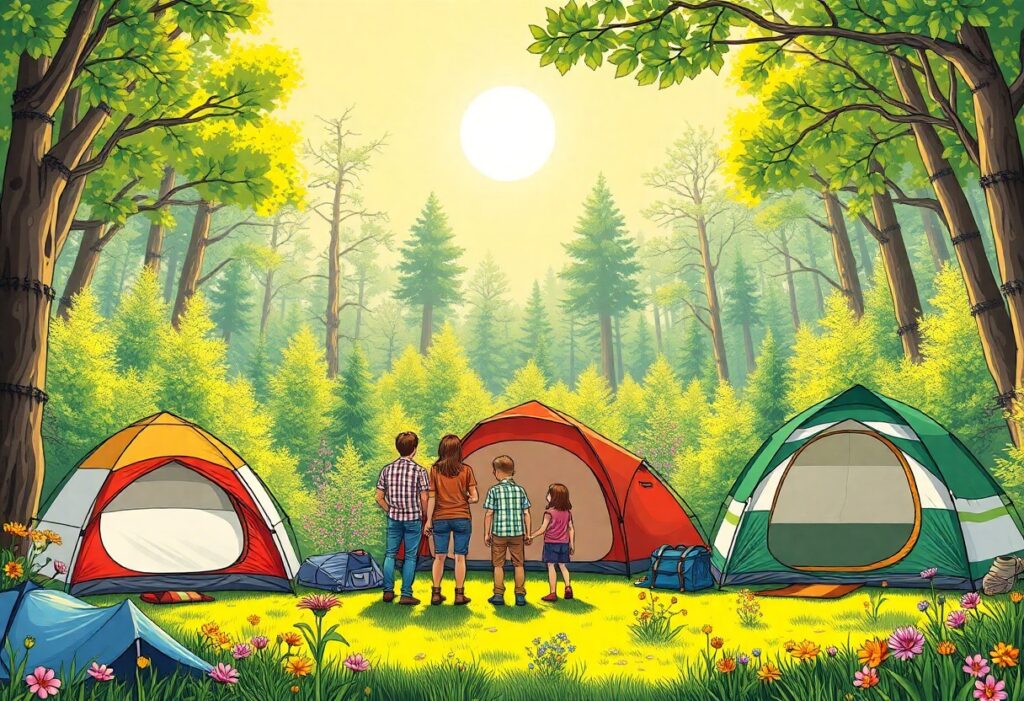Camping in the spring presents unique challenges, making the selection of the right tent necessary for an enjoyable experience. With fluctuating temperatures, potential rain, and varying terrain, you need a shelter that can withstand these elements while providing comfort and safety. Choosing the right tent ensures that you stay dry, warm, and protected from unpredictable weather. In this post, we will explore key factors to consider when selecting a tent for your spring camping adventures, ensuring that your outdoor experience is both memorable and enjoyable.
The Importance of Tent Selection
Before you begin on your spring camping adventure, choosing the right tent should be a top priority. A well-selected tent not only provides shelter but also enhances your overall camping experience. With varying weather conditions and diverse terrains encountered in spring, your decision can significantly affect your comfort, safety, and enjoyment while exploring the great outdoors.
Weather Considerations
Tent selection must account for the unpredictable weather of spring. Rain showers, wind, and temperature fluctuations can all impact your camping experience. By choosing a tent designed for varied conditions, you ensure adequate protection from the elements, allowing you to focus on the adventures that lie ahead.
Terrain and Location
Between the lush forests, rocky hills, and sandy beaches you’ll encounter while spring camping, the terrain plays a significant role in your tent selection process. You’ll want a tent that performs well in the specific environment you’ll be exploring.
The right tent for your destination should factor in the ground conditions and potential obstacles you may face. For instance, if you’re camping on uneven or rocky terrain, a lightweight tent with sturdy poles and a good footprint is necessary for stability. In contrast, if you plan to camp on soft ground, a tent with a higher waterproof rating may be advantageous. Tailoring your choice to the specific landscape will ensure that your tent provides the comfort and security necessary for a successful outing.
Types of Tents for Spring Camping
Some tent types are better suited for spring camping than others. Consider the following options when selecting your ideal tent:
| 1. Backpacking Tents | Lightweight and portable, ideal for hiking trips. |
| 2. Family Tents | Spacious and comfortable for groups or families. |
| 3. Dome Tents | Stable and weather-resistant, well-suited for wind. |
| 4. Pop-Up Tents | Easy to set up, great for quick getaways. |
| 5. Cabin Tents | Roomy with vertical walls, good for larger groups. |
The right tent choice can enhance your spring camping experience, ensuring comfort and protection from the elements.
Backpacking Tents
Around spring, lightweight backpacking tents become important for your outdoor adventures. These tents typically weigh less, making them easy to carry on hiking trips. They are compact and designed for quick setup, ensuring you can rest without hassle after a long day on the trails.
Family Tents
With spring camping, family tents provide ample space for everyone in your group. They are designed to accommodate multiple occupants and gear, making them perfect for family outings or trips with friends.
To maximize comfort, family tents often come with features such as multiple rooms, higher ceilings, and windows for ventilation. Look for options with waterproof materials and durable construction to protect your loved ones from spring rain. This way, everyone can enjoy the great outdoors while staying cozy inside the tent. Choose the right family tent, and you’ll create lasting memories on your spring camping trips.
Key Features to Look For
Any potential camper should consider several key features when selecting the ideal tent for spring camping. Focus on:
- Waterproof materials
- Durable zippers and seams
- Good ventilation systems
- Easy setup and takedown
- Weight-to-space ratio
- Interior pockets for storage
- Weather resistance
The right combination of these features can greatly enhance your camping experience.
Waterproofing and Ventilation
Against unpredictable spring weather, ensuring your tent is waterproof is imperative. Look for tents with high hydrostatic head ratings and sealed seams to keep you dry during sudden rain. Adequate ventilation is equally important, as it helps mitigate condensation build-up, allowing fresh air to circulate. Opt for tents with mesh panels and adjustable vents to maintain comfort even when the temperature fluctuates.
Size and Weight
Against the elements, the size and weight of your tent matter significantly, especially if you’re hiking to your campsite. A lightweight tent that fits your group size is ideal, as it makes transport easier while providing adequate space for sleeping and storing gear.
Hence, considering the balance between size and weight is imperative when selecting a tent. A compact, lightweight design is beneficial for backpackers who value mobility, whereas family campers may prioritize living space and comfort. Always aim for a tent that offers ample room without becoming cumbersome to carry.
Set-Up and Ease of Use
Once again, the ease of setting up your tent can greatly impact your overall camping experience. A tent that is simple to pitch allows you to spend more time enjoying the outdoors rather than struggling with assembly. Look for features like color-coded poles or quick-clip systems that simplify the process. Ultimately, a tent that is user-friendly will contribute to a more relaxed and enjoyable camping trip, especially when unexpected spring weather conditions may push you to set up quickly.
Fast Pitch Tents
Tents designed for quick setup can be a game changer for your spring camping adventure. These fast pitch tents often utilize pop-up designs or instantaneous poles, enabling you to pitch your tent in mere minutes. This feature is especially beneficial in spring, where weather can change unexpectedly, allowing you to focus on settling in rather than fussing with complicated instructions.
Traditional vs. Modern Designs
Beside the speed of setup, choosing between traditional and modern tent designs can influence your camping comfort. Traditional tents often come with classic poles and require a bit of time for setup, while modern tents may feature innovative designs that enhance convenience and usability. Understanding these differences is key to selecting a tent that meets your specific needs for spring camping.
Considering the advancements in tent design, modern tents often provide enhanced features such as better ventilation, waterproof materials, and lightweight structures that are not typically found in traditional designs. You should weigh your options depending on your camping style; if you value speed and convenience, modern options are likely more beneficial. On the other hand, if you appreciate rugged reliability, traditional designs may serve you well. Evaluate your priorities before making your decision to ensure a pleasant experience during your spring camping trip.
Budgeting for Your Tent
For most campers, getting the best tent on a budget is a key part of the planning process. Investing in a tent that suits your needs and preferences can enhance your overall camping experience. Set a realistic budget that considers important features such as size, weight, material, and weather resistance. By prioritizing imperative aspects, you can find a tent that not only fits your financial plan but also provides comfort and shelter during your spring adventures.
Cost vs. Quality
Across the camping gear market, you will encounter a range of tents at various price points. While cheaper tents may seem appealing, they often lack durability and reliability, especially in unpredictable spring weather. It’s imperative to weigh the cost against the quality of materials and craftsmanship. Investing a bit more in a well-made tent can save you from potential discomfort and disappointment during your trips.
Long-Term Investment
With frequent camping trips in mind, purchasing a tent can be viewed as a long-term investment. This means you should consider not just your immediate needs but also how well the tent will serve you over time. A quality tent can last for years and accompany you on countless adventures, making it a financially wise decision.
And as you think about your future camping experiences, consider the value of a tent that withstands different conditions. A durable and reliable tent will not only provide shelter but also enhance your overall camping experience. By opting for a higher-quality tent, you reduce the frequency of replacements and repairs, ultimately saving money in the long run. Prioritizing long-lasting materials and reliable construction can make your camping endeavors enjoyable and hassle-free.
Maintenance and Care
To ensure your tent remains in top condition for spring camping, regular maintenance and care are imperative. Frequent inspections for wear and tear, proper cleaning, and mindful storage practices will extend the life of your gear and enhance your outdoor experience. By being proactive in your care routine, you can enjoy trouble-free adventures while keeping your tent functional and ready for your next escapade.
Cleaning Your Tent
Around your camping trips, it’s important to keep your tent clean. After each use, shake out dirt and debris, and clean it with mild soap and water when needed. Remember to avoid harsh chemicals that could damage the fabric or waterproof coatings. Allow the tent to dry completely before packing it away to prevent mold and mildew.
Storage Tips
With proper storage, your tent can last for many seasons. Always store your tent in a cool, dry place away from direct sunlight, and use a breathable bag to prevent moisture buildup. Avoid folding it in the same creases to minimize wear. Consider these tips:
- Store in a dedicated container to protect from pests.
- Check zippers and seams before long-term storage.
- Thou should always ensure it is completely dry before sealing it away.
Tent storage is just as vital as its cleaning and maintenance. Store your tent loosely rather than tightly packed, allowing the materials to breathe. Utilizing a storage bag that is breathable will help mitigate any moisture retention. Keep the tent in a location free from humidity, and inspect it annually for any signs of damage. Follow these guidelines:
- Use a dedicated storage area away from heat sources.
- Rotate your tent in its bag to avoid creasing.
- Thou should take care that all components are clean and dry before putting it away.
Summing up
The right tent can make all the difference for your spring camping experience. As you consider factors like weather conditions, terrain, and your own comfort, choosing a tent that meets your specific needs ensures you stay dry and cozy during unexpected spring showers. A well-suited tent not only enhances your outdoor adventure but also provides a secure space for relaxation after a day of exploring. By prioritizing the right features for your camping style, you set the stage for memorable moments in nature.

